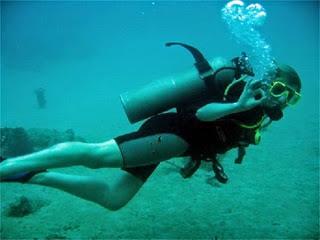
You’ve got your Scuba certification, you’ve got your Scuba gear, and now you’re itching to go on your first Scuba dive. And sure, the certification process reviewed all the basics, but there are still other practicalities that an informed diver should know. This article will outline the methods and precautions observed by safe divers around the world.
Attraction - There are many sights under the water including coral reefs, shipwrecks, caves, and any assortment of plants and animals. Coral reefs are found mainly in tropical climates. Shipwrecks and caves can be found almost anywhere.
Visibility - Under the water, visibility can vary from as little as 2ft. to over 100ft. This depends mainly on sea conditions, but can be affected by weather as well. In the Northern Pacific and Northern Atlantic, you will find visibility to be very limited, while in tropical climates, you can see the sun from over 100ft down!
Depth - Recreational divers should not dive below 130ft without advanced training and equipment. The deeper you dive, the higher the risks for injury. As you go deeper, less light can penetrate the water and the ocean becomes darker. Also, the deeper you go, your risk increases of getting Decompression Illness. These conditions may be very stressful for a beginning diver. It’s recommended that you dive no deeper than 60ft until you become more comfortable with scuba diving situations. Additionally, due to the compression of air at depth, you use a greater percentage of air with each breath, thus reducing your total dive time.
Temperature - Scuba divers often wear wetsuits to protect themselves from the cold. In most parts of the ocean, there is a temperature gap where in a change of depth of 1 foot, there may exist a 10 degree decrease in temperature, this is called a Thermocline. In some circumstances, in tropical climates you will need only a bathing suit.
Water Conditions - Surf and current are the basic sea conditions you need to know. Currents can be very strong in some areas and can carry a diver away. Even many popular dive sites have very strong current areas suitable only for experienced divers. Be sure you know how strong and in which direction the current is flowing. The current can also be part of the experience; a "drift dive" is a dive that is designed to have you be carried by the current. A boat must be present and the skipper will follow you on the surface by watching for surfacing bubbles. Surf can affect the boat and how safe it is getting in and out of the water.
Wildlife - Observing the local wildlife can be the most rewarding experience of an underwater dive, but it can also be quite dangerous. Every geographical location on Earth has its own unique species. You should know the basic fish and plant life you are likely to encounter and if there are any precautions for dealing with any. Just about all of them are harmless and are more scared of you than you are of them.
Reprinted from wikiHow
Kathy Dowsett
kirkscubagear.com